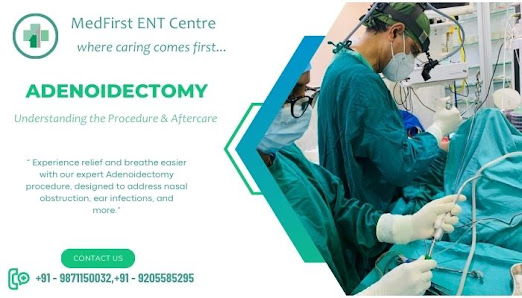Adenoidectomy is a surgical procedure designed to remove enlarged adenoid tissue located in the nasopharynx, which can cause various health issues, particularly in children.
Indications for Adenoidectomy:
- Enlarged adenoids leading to nasal obstruction and disrupted sleep patterns in children.
- Enlarged adenoids causing recurrent middle ear infections, ear pain, and hearing problems in children.
- As part of a combined procedure, such as Myringotomy with Grommet insertion.
The Procedure: Adenoidectomy is typically performed through the mouth, without any external incisions. The ENT surgeon uses a mouth gag and tongue depressor to access the nasopharynx. Soft tubes inserted through the nostrils help retract the soft palate, providing access to the adenoids. The surgeon then removes the adenoid tissue, either under direct vision or using angled endoscopes. The entire procedure takes approximately half to one hour, depending on the technique used.
Methods of Adenoidectomy:
- Regular Cold Steel Adenoid Removal: Using specialized instruments.
- Coblation Assisted: Utilizing a Coblation wand to remove adenoid tissue with heat.
- Microdebrider Assisted: Involving special microdebrider probes and suction for tissue removal.
Complications: Complications of adenoidectomy are categorized into two groups: I. Complications of Anesthesia: These should be discussed with the anesthetist and may include drug-related side effects and sedation. II. Complications of the Surgery:
- Bleeding: Minimal bleeding is common, but excessive bleeding may occur intraoperatively or postoperatively. Secondary hemorrhage can be managed with antibiotics.
- Infection: Postoperative infections are possible, and prophylactic antibiotics are often prescribed.
- Nasal Regurgitation: Occurs if excessive tissue is removed but typically resolves over time.
- Change of Voice: Bulky tissue removal may alter the voice, particularly in child artists or singers. Consultation with a surgeon and speech therapist is advised.
Postoperative Care:
- Regular nursing care.
- Proper nutrition with minimal dietary restrictions (avoidance of spicy, hard, and sour foods for a period).
- Medications and prescribed gargles.
- Follow-up visits with the surgeon, including a review of the histopathology report.
Understanding adenoidectomy, its indications, and postoperative care is essential for ensuring a smooth recovery and improved overall health.

